It is true some prefer the revolver and some prefer the automatic regardless of cartridge, but sometimes the handgun is chosen on the basis of its chambering. The 357 Magnum revolver is often chosen over the 9mm pistol for the former’s terminal ballistics. Shooters might honestly prefer a self-loader, but they are hedging their bets and obtaining a cartridge with a proven defense record. They realize the 357 Magnum handgun is limited in capacity from five to eight rounds, and the eight-shooters are pretty big guns. In reality, most personal-defense Magnums are five- or six-shooters. The flash, blast, and recoil of the Magnum and its smaller reserve of ammunition at the ready are deemed justifiable trade-offs for more power.
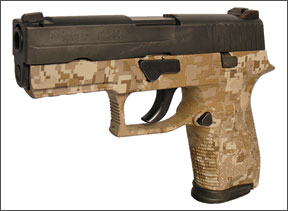
In contrast, the 9mm is available in a myriad of pistol choices, and some revolvers. There are 357 Magnum self-loaders as well, but they are pretty heavy propositions. For defensive use, most carriers choose the 9mm for its low recoil, good control, and adequate downrange ballistics. Some like the idea of firing a group on the target that is well centered, while others feel that a single heavy hit in the X ring is the way to go.
It should be noted that the 357 Magnum is among a very few “small-bore” revolvers that has earned a good reputation for performance even with non-expanding bullets. The 160-grain SWC at 1300 fps or so, used by professional lawmen from 1935 on, was deemed a good choice for police work for a reason. With the heaviest loads, the Magnum certainly lives up to its reputation for excellent penetration. As a caliber for defense against animals or against light cover, the Magnum has no peer. The 9mm, however, has relied upon reasonably good ballistics and fast repeat shots to do the business. Each has its adherents. However, the situation has changed to an extent, as far as the performance of each cartridge.
It’s true that 9mm ballistics have been improved considerably, with some loads operating at +P and +P+ pressures and topped with great bullets. At the same time, the 357 Magnum is no longer a proposition only for heavy revolvers; relatively light five-shot revolvers with short barrels are widely available, so some versions of the Magnum cartridge have been loaded down for personal defense.
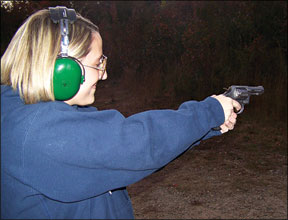
So, if we compare the handguns that are purpose-designed for defense use, does the Magnum really have that great an advantage? That was the question we wanted to answer. To make the comparison fair, the pistols would have to have similar barrel lengths and be geared toward personal defense. We were not concerned with penetration against animals; we have done that with the 357 Magnum and found that the full-power Magnum as loaded by Cor-Bon and a few others is a credible and effective loading for this purpose. Rather, we were interested in comparing the ballistics of loads intended for personal defense.
Comparing the .357 and 9mm Cartridges
The 357 Magnum cartridge case is 1.29 inches long. Powder charges are often as heavy as 16 grains of slow-burning powder. SAAMI sets maximum pressure for the 357 Magnum at 35,000 psi. The 9mm Luger case is 0.754 inches long. Powder charges range from 4 to 7 grains of fast-burning powder. The maximum pressure for the 9mm is 34,000 psi.
When you look at the paper figures, it would seem the shorter 9mm is far more efficient. This is true when bullets of 100 to 124 grains are considered. The 9mm gets plenty of velocity worked up in its short case. However, the short case does not allow the use of heavier bullets at high velocity. As such, 147 grains is the practical limit for 9mm defensive bullets. The maximum velocity with these bullets is generally regarded as about 1000 fps. The 357 Magnum offers superior energy and velocity with heavy bullets at the expense of greater recoil. Muzzle blast is also a drawback. Muzzle flash is usually the result of slow powder burning outside of the barrel instead of inside the barrel, which is a mark of a load that is inefficient in that barrel length. On the other hand, many 9mm loads exhibit very little flash, sometimes just a few sparks. When it comes to the light 100-grain bullets, the performance of the 357 Magnum is limited by bullet pull. With a proper formulation and good powder technology, the 125- to 145-grain loads may be very efficient. There is also more leeway in the revolver cartridge to use bullets with an open nose. Such bullets would never feed properly in many 9mm pistols, but the wide-mouth hollowpoints really expand when they hit water.
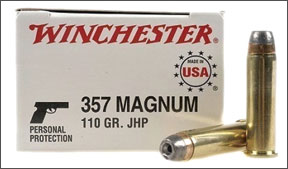
To compare 9mms to 357s, we selected a half-dozen loads in each caliber. We are certain there are similar loads in either caliber that may have done better or worse, but in all probability, the results would likely have been similar when weights, powder payloads, and bullet styles are considered. In the end, the loads tested are representative of the breed.
Also, the handguns used were representative of the types actually carried for personal defense. No long-barrel Magnums were used. All of the test firearms featured barrels of 3.5 to 4 inches. While the test was predicated on the desire to compare the cartridges, we cannot help but comment on the difference between the handguns. The reciprocating slide of the self loader soaks up some energy on firing the 9mm, while the smaller powder charge makes for lower recoil energy. An instant second shot is available, and the magazine capacity of the 9mm is always greater than the Magnum, even when compact 9mm pistols are used. The revolver’s primary advantage may be reliability, but the advantage over modern self loaders may be more theoretical than real. The fact is, few revolvers will stand up to thousands of full-power 357 Magnum cartridges, while quality 9mm pistols will digest well over 10,000 rounds without complaining. The Magnums don’t blow, but the small parts take a beating. An advantage that was obvious in firing a number of rounds in the Magnum revolvers, particularly the Smith & Wesson revolvers used, was accuracy. The Model 66 and the Model 27 used in firing test would literally cut a single hole at 25 yards. Accuracy was superb. These handguns are capable of striking 4-feet-tall by 2-feet-wide targets on demand at 100 yards in the hands of practiced shooters. Modern double-action-only pistols such as the SIG P250 are certainly combat accurate and useful, but will never be as accurate in slow fire as a good revolver. Some other things we noticed:
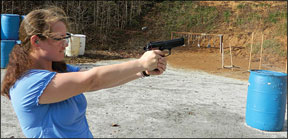
– Recoil. It isn’t all about power factor. While power factor might show that the same loads — say, 110- to 115-grain bullets at 1250 fps — should be similar in felt recoil, there is definitely a large difference between the platforms. The revolver kicks more.
– Muzzle Blast. Again, round for round, the muzzle blast of the Magnum is often more disconcerting than the recoil. This is particularly true of some of the maximum-effort loads that are really at their best in longer barrels. This is because more powder is used in the longer case.
– Terminal Ballistics. There is an argument for the Magnum when you consider the extraordinary performance of a relatively few loads such as the 130-grain Hydra-Shok, which produced 632 foot-pounds of energy and a Power Factor of 192. The potency of the Magnum is attractive for those who are able to handle the cartridge. The 9mm simply cannot push a 124-grain bullet to 1350 fps, while the 357 Magnum can push a 125-grain bullet to more than 1400 fps. If you favor a heavy bullet and deep penetration, even the 3-inch-barrel 357 Magnum will best a 147-grain 9mm (tested previously) by some 150 fps, as the Winchester Silvertip demonstrates.
Our Team Said: If you are willing to deploy at least a K-frame revolver with a 4-inch barrel, the 357 might offer a significant advantage in downrange power. In the end, for the shooter interested in a good personal defense pistol, the 9mm loaded with the best modern +P load seems the better choice, in our opinion. Practice with standard-pressure 9mm loads gives meaningful practice and training. On the other hand, practicing with 38 Special in a Magnum will often give the shooter a false sense of confidence because the Magnum kicks much harder than the 38 Special. While the 357 is more accurate in slow fire, the automatic pistols seem to have better hit probability and control. Backup shots are much faster and more sure. The advantage of the Magnum comes when you need greater penetration. Load by load, here’s what our shooters said about the test rounds:
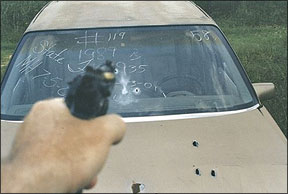
357 Magnum Glaser Pow’RBall 100-grain PB 357100, $22/20
The Pow’RBall bullet was originally developed to offer perfect feed reliability in any type of self-loading pistol. The bullet features a wide nose plugged with a polymer ball. Feeding is a given, however, the polymer plug is pressed into the hollow nose cavity, so on meeting resistance, expansion is also enhanced. The Pow’RBall actually fragmented. Compared to the 9mm Pow’RBall, the 357 version showed 2 inches greater penetration with a 60 fps velocity advantage. This load demonstrated the lightest recoil of any Magnum load.
357 Magnum Cor-Bon 110-grain JHP SD357-110, $25/20
This is another 110-grain load, but one with a far different performance profile. In the past, the 110-grain loads were usually loaded down for use as a personal-defense load, while the 125-grain JHP loads were considered service loads. The Cor-Bon load uses the Speer Gold Dot hollowpoint and loads the cartridge to produce nearly 1400 fps. The result is excellent penetration and expansion. This load virtually equals the heavier 140- to 145-grain loads in performance, but with lighter recoil. Accuracy is excellent. As an all-round load useful in a variety of scenarios, it’s our top choice among the 357 Magnums.
357 Magnum Winchester USA 110-grain JHP Q4204, $33/50
This loading is attractively priced in a 50-round box. The combination of relatively low recoil and rapid fragmentation makes for a load well suited to urban or home-defense scenarios. The open-nose bullet, coupled with serious creases in the jacket, make for a bullet that rapidly expands and almost always fragments. This is a load very similar to the original Super-Vel 110-grain JHP, although sensibly downloaded for good control. The 50-round box and easy availability make this load a Best Buy among the Magnums.
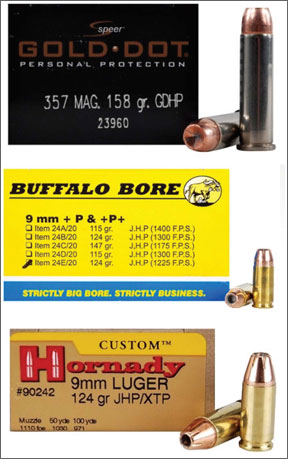
357 Magnum Speer 125-grain Gold Dot HP 23920, $25/20
The Gold Dot loads produced the greatest penetration numbers in the test, but also the greatest flash and blast. Expansion is good, penetration certainly adequate. We liked the performance of the Cor-Bon 110-grain load better, however, as recoil was less and so was the muzzle blast, yet there wasn’t a nickel’s worth of difference in performance, with the 110-grain load actually expanding more. Just the same, if you like the 125-grain JHP, this is a good choice.
357 Magnum Federal Premium Personal Defense Reduced Recoil 130-grain Hydra-Shok JHP PD357HS2 H, $24/20
This load is offered in the Personal Defense line, which usually means less velocity and recoil with a bullet designed to expand at low velocity. It is advertised at 1300 fps. Perhaps we obtained a different lot than others have, but this is the load we have clocked for going on 18 months in several examples, and performance has been over 1450 fps! This load clocked 1480 fps. Yet, recoil was little more than the Gold Dot and no more at all than the 145-grain load. Expansion and fragmentation were certainly there. This is a maximum-effort load for those who prefer fragmentation. No 9mm load comes close to this one.
357 Magnum Winchester Super-X 145-grain Silvertip JHP X357SHP, $51/50
The price is only high until you consider this is a 50-round box. It is actually less expensive than most rounds offered in 20-round boxes. Recoil was the highest, subjectively, and big muzzle blast plainly evident. However, penetration and expansion were very consistent at about 16 inches and .70 caliber expansion, with the average running just under .70 expansion. Coupled with the heavy bullet, this is impressive performance. Recoil is greater than the lighter-bullet weights. There were no 9mm loads to equal this Magnum. If you are deploying the Magnum in the winter against thick clothing, this may be the best choice.
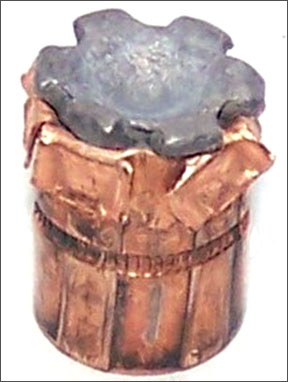
357 Magnum Speer Gold Dot 158-grain JHP 23960, $27/20
This is more of a hunting load than a personal defense load, but someone was bound to say we didn’t test heavy-bullet loads — so here it is. Truth be told, performance was better than we expected. Expansion was not as good as the others and penetration was on the long end as far as our protocols go. This is a deer load, not a personal-defense load, but it wouldn’t be the worst choice for the latter in certain circumstances.
9mm Luger +P Glaser Pow’RBall 100-grain PB09100, $24/20
This is a light-recoiling load with plenty of velocity. The Pow’RBall isn’t going to misfeed, and despite the light bullet, function was good in a number of 9mm pistols. Expansion leans toward fragmentation. All of the Magnum loads had 2 inches of penetration on this 9mm. While a decent load, we prefer the 115-grain bullets.
9mm Luger Black Hills 115-grain EXP JHP D9N620, $14/20
This is the Best Buy 9mm. EXP means Extra Power. This is the fastest possible load without moving into +P territory. The bullet doesn’t fragment but plumps up admirably. Overall, it’s a good load that recoils less than the Magnum but offers good performance.
9mm Luger +P Cor-Bon 115-grain JHP SD09115/20, $21/20
Cor-Bon gave defense shooters a leg up with this 9mm, the first generally available +P load equaling restricted LEO +P+ performance. This is still the load to beat. Accuracy was good and muzzle flash practically nonexistent. We would like more penetration, but the performance of this type of load has been proven.
9mm Luger Hornady Critical Defense 115-grain Flex Tip eXpanding 90250, $19/25
Two things stand about concerning this load — low recoil and affordability. This is a fairly mild standard-pressure load that uses the Critical Defense bullet. This bullet features a polymer plug that is tolerant of intervening material, but which expands on meeting resistance.

Both penetration and expansion are adequate. Most of our testers prefer more smash, but this is a good standard-pressure choice.
9mm Luger Hornady Custom 124-grain XTP JHP 90242, $18/25
This load was the slowest tested. Recoil was very easy to manage. Accuracy was excellent. We might wonder why this load would be a good pick, and the answer is in the performance. While recoil is mild and velocity less than 1100 fps, the load has among the deepest penetration of any 9mm tested and offers good expansion.
9mm Luger +P Buffalo Bore 124-grain JHP 24E/20, $24/20
The Buffalo Bore load is the single most impressive 9mm load tested. Compared to the Magnum loads, the Buffalo Bore 9mm comes up short to the best performers, but easily outperforms several as well. While this load (and the Ranger load) demonstrated the greatest felt recoil of the 9mm loads, control was good and in no case was the firing unpleasant. Looking at this .70-inch-expanded bullet, we see little reason to adopt a lightweight Magnum when the Buffalo Bore load is controllable and available.
9mm Luger +P Winchester Ranger T 124-grain RA9124TP, $43/50
The Ranger line was developed for law enforcement, and it shows in this cartridge. This load would have been a conditional best buy if there were a steady source for the load. Winchester restricts some loads to law enforcement use, and it is catch as catch can on this one. Nevertheless, we had little problem obtaining several boxes at a fair price. Both expansion and penetration are ideal. The bullet doesn’t fragment, but plumps up to .64 inch on average. Cartridge integrity is good, and accuracy is excellent. If more police agencies issued this round, the 9mm Luger would not have been replaced by the 40 S&W, in our opinion.
Written and photographed by R.K. Campbell, using evaluations from Gun Tests team testers.


























